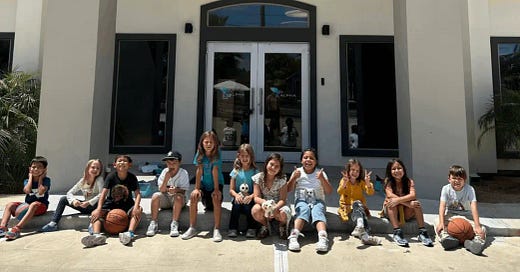Austin Scholar #132: You need to change how you’re talking to your kid about school
& 2 Hour Learning in Brownsville, TX
Hey, y'all!
This week from Austin Scholar...
Austin’s Anecdote: 2 Hour Learning in Brownsville, TX
You need to change how you’re talking to your kid about school
Scholar’s Sources: What I’ve been thinking about
So: my family has officially moved!! For me, of course, this means having packed up all of my stuff this last week, unpacking and living in our new home for two weeks, then packing back up to move to California. I’m in love with my new room (instead of sleeping in my closet, I have an actual bed and my desk is perfect for newsletter writing). If my parents wanted to have an excuse for me to want to come home for every break, they’ve now got one :)
In other news, I finally landed my first off-ice axel (practicing the jump in my socks and in my living room), so now I just have to get over my mental blocks and land one in my skates. I’ve also refreshed my Algebra II by helping my sister and her friends with their math, and I’m 40% completed with Calculus II on Math Academy. Overall, it’s been a very productive, physically taxing, and fulfilling week.
Austin’s Anecdote: 2 Hour Learning in Brownsville, TX
Whenever I post about 2 Hour Learning on Twitter/X, I receive a ton of comments arguing that this way of learning only works for “smart people” and that it “wouldn’t work for anyone who wasn’t already in the top 10% nationwide.”
Additionally numerous studies in the United States discuss the link between income and education. For example, studies show that lower-income students typically perform 3 academic years behind median-and-high-income students.
And according to these studies, low-income students enter high school 5 years behind their counterparts when it comes to literacy skills.
Unfortunately, “the fates of generations of poor children [are] largely sealed before they even set foot in a classroom.”
But it’s not their socioeconomic status – or even all of the other factors related to that status – that cause this disparity.
How can I make this claim? Well, two years ago, my school decided to open up a campus in one of the poorest cities in America: Brownsville, TX.
In Brownsville, over a third of its citizens live in poverty.
But its Alpha campus was run in the same way as our Austin campus: using online apps to learn instead of teachers.
As you can imagine, the socioeconomic status of the students at the Brownsville campus was vastly different than that at the Austin campus.
But you’ll be shocked to see the results.
After one year at the Brownsville campus, students were learning 1.4x as much as the average student in a traditional classroom would.
As expected, however, our Austin students significantly surpassed this at 2.4x.
But just one year later, their performance accelerated past our Austin students.
We didn’t expect that.
Brownsville learned at 2.9x compared to the average student in a traditional classroom, and Austin learned at just 2.6x.
And yes, your understanding is correct – the low socioeconomic students living in one of the poorest cities in America surpassed the students living in the city with the fastest-growing number of millionaires. And they continue to do so.
The impact of this new way of learning is best demonstrated through the accomplishments of some of the individual kids.
One student from Brownsville completed a 3-week “get to grade level” sprint.
Through her app learning, she was able to catch up by 1.5 grade levels in 3 subjects during this time.
1.5 grade levels in 3 weeks – all through online apps.
This never would have happened in a traditional school setting.
Another student joined Alpha Brownsville this year.
His math achievement level when he joined was the 22nd percentile.
After just four months of learning through apps, his math achievement percentile absolutely skyrocketed to the 94th percentile.
He went from being in the bottom third nationally to the top 10%.
He’s 5 years old.
These two students – along with so many others – have opened the doors to so many more opportunities for themselves through their education.
This year, Texas Preparatory School is adopting 2 Hour Learning (using online apps to learn all academics) to help its students catch up in their academics and set them up for success later in their life. 2 Hour Learning will help its students at this charter school go from the bottom 10% in the country (not able to read or do basic math) to the top 10%.
Online apps are the great equalizer.
If we want to give every single child a chance of success – regardless of their socioeconomic status – then use apps to learn.
You need to change how you’re talking to your kid about school
Parents: you need to change how you’re talking about school.
One thing that is almost universal in students who aren’t doing as well in school as they could be is that their parents have a terrible rhetoric around academics and learning at home.
Their parents say things like:





